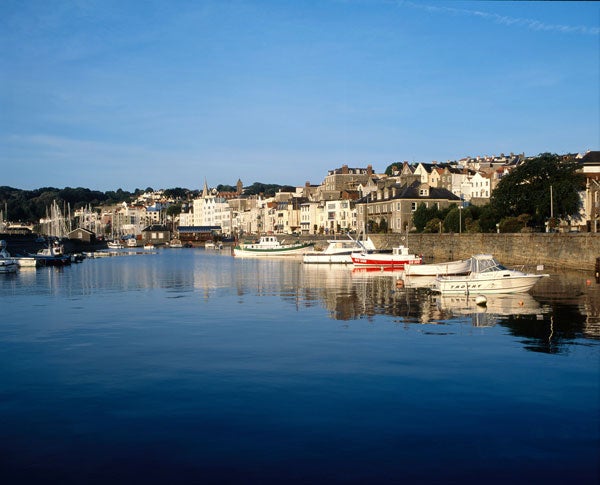Trail of the unexpected: Victor Hugo’s Guernsey
The author of 'Les Misérables' relished exile in Guernsey. Nick Boulos traces his steps

Not everyone starts their day with two raw eggs washed down with a cup of cold coffee and an icy strip-down wash in full view of their neighbours. But then, not everyone lived life like Victor Hugo did.
The 19th-century French poet, playwright and novelist was an arch- republican during the time of Napoleon III. Because of his outspoken political views he was exiled from his homeland. He fetched up in Jersey in 1852, and moved on to Guernsey in 1855. He spent 15 highly productive years there, the island's "severe yet gentle" beauty inspiring him to write Toilers Of The Sea.
Hugo didn't have the most auspicious arrival: his unfinished manuscript of Les Misérables was almost swept overboard into the choppy Channel following his stormy crossing from Jersey. But during his time on Guernsey he roamed the clifftops and bays, strolled the cobbled streets of the capital, St Peter Port, and browsed in the antiques shops. As a result, the island lists more than 40 points of interest to Hugo enthusiasts, and a guided walk of St Peter Port is good way to tick off a fair few of them.
My guide, Gill Girard, leads me from a medieval harbour where Hugo first arrived and into deserted, cobbled backstreets in the Old Quarter. This is where the writer had his hair cut daily. Before reaching Hugo's imposing Victorian home, we pause at a more modest property several doors down.
The terraced house at number 20 was home to Juliette Drouet, Hugo's long-term mistress, who joined him in Guernsey following his exile.
"His wife, Adele, knew all about it. There was a mutual understanding," says Girard. "The couple would communicate to each other by tying coloured hankies to the railings outside their homes: white if they'd slept well; black if they hadn't."
Hugo's three-storey Hauteville House, easily the grandest on the street, is now owned by the City of Paris. We are shown into the hallway, which is surprisingly dark and oppressive. A creaky wooden staircase spirals out of view; heavy doors and intricately carved wooden panels line the walls.
According to Girard, the property, with its secret doors and bold interiors, was designed to intrigue and challenge visitors, reflecting Hugo's view that knowledge leads one into the light. His glass, rooftop lookout, reached via the third-floor library, allows a column of sunlight to illuminate the length of the staircase. A simple, drop-down table in his study is the place where Hugo put the finishing touches to Les Misérables. This room was a haven; he would sleep, write and (much to the dismay of his neighbours) wash up here, savouring sea views over the neighbouring Channel islands of Sark, Herm and, on a clear day, France. He likened his house to "a seagull's nest high above the immense foam of the waves".
Later, I retrace Hugo's footsteps on a walk he described as a "spectacle full of enchantment". Having worked all morning, the author would often spend an afternoon on the pebble beach at Fermain Bay.
The coastal trail weaves its way along towering granite cliffs before descending into a hushed, lilac landscape of bluebell woodland. Before long, Fermain Bay appears far below, surrounded by lush trees clinging to the cliffs that jut out into the sea. A solitary boat rocks amid the blue water, which fizzles over the large, grey pebbles where Hugo would read his mail and write love letters to Drouet in between taking dips in the Channel.
The next day I stroll along the succession of long, sandy bays around Port Soif on the north coast. It was here – somewhere – that Hugo made the ultimate purchase: his very own island. The exact location of his rocky atoll is a mystery, but Hugo's private getaway is known to be one of the many nutmeg-brown isles along this shore that are accessible only at low tide. Necker Island it isn't – but the coast is striking nevertheless. Surfers brave the biting waters as families walk among the rolling caramel sand dunes that border the beach, seaweed strewn across it like emerald ribbons.
Hugo became utterly consumed by the "wild and picturesque" nature of this part of the island, often identifying strange shapes in the rocks – his "lion and camel" can be found at Cobo Bay.
Back in St Peter Port, I let myself into another must-visit spot. Ask nicely at the Guernsey Museum and you are loaned a long, iron key to Victoria Tower.
I climb the twisting stairs to the top for views over the city, sea and countryside. Hugo and his lover stole precious moments here. Like lovesick teenagers, they were said to have carved their initials somewhere in the tower, though no one has ever found them.
Travel essentials: Guernsey
Getting there
* Sail from Weymouth, Poole and Portsmouth to Guernsey with Condor Ferries (0845 609 1024; condorferries.co.uk).
* The writer travelled with Aurigny Air Services (01481 822886; aurigny.com ), which flies from Gatwick, Stansted, East Midlands and Manchester. Flybe (0871 700 2000; flybe.com ) has links from Belfast City, Birmingham, Edinburgh, Exeter, Manchester, Gatwick, Newcastle, Norwich and Southampton – the last of which is also served by Blue Islands (08456 20 21 22; blueislands.com ).
Staying there
* Doubles at Bella Luce (01481 238764; bellalucehotel.com) start from £130 per night.
Visiting there
* Local guide Gill Girard (07781 104094; gillgirardtourguide.com) leads 90-minute Victor Hugo walks for £5.
More information
* Guernsey Tourist Board: 01481 723552; visitguernsey.com
Join our commenting forum
Join thought-provoking conversations, follow other Independent readers and see their replies
Comments